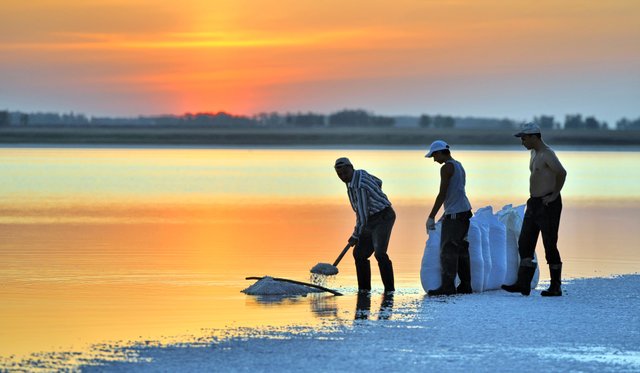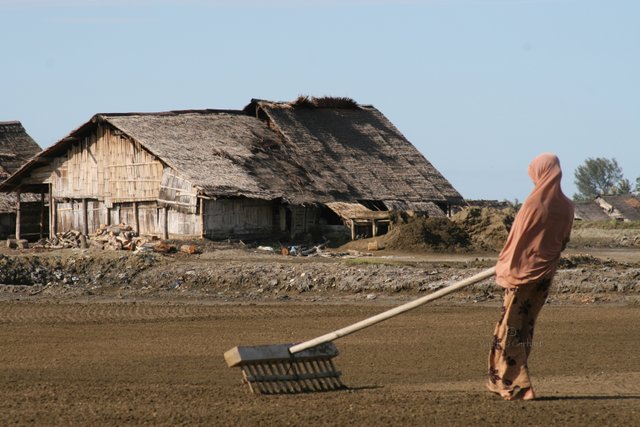Garam Antara Aceh dan Madura (Salt between Aceh and Madura)
Akhir tahun lalu Aceh dihebohkan dengan berita keengganan MPU menerbitkan sertifikasi halal bagi produk garam lokal. Alasan MPU industri garam rakyat di Aceh tidak memenuhi standar halal secara syar'i. Polemik itu menjadi momok menakutkan bagi para pemilik lancang sira yang bertebaran di seantero Aceh. Prinsip kehati-hatian yang diterapkan MPU bersumber dari observasi langsung dimana garam diproduksi pada lahan yang disinyalir rawan tercemar kenajisan.
At the end of last year Aceh was overwhelmed with news of the reluctance of MPU (Ulama Council) to issue halal certification for local salt products. The reason MPU of the community salt industry in Aceh does not meet halal standards in syar'i. The polemic was a frightening specter for salt farmers scattered throughout Aceh. The principle of prudence applied by the MPU comes from direct observation that salt is produced on open land which is allegedly prone to impurity.
Pada saat yang sama di pulau garam Madura, petani garam juga sedang diruwetkan oleh masalah lain yang sama sekali berbeda dengan apa yang dialami sejawat mereka di Aceh. Di Madura produksi garam sepanjang tahun 2017 merosot drastis akibat musim kemarau yang tidak menentu. Ditengah kemerosotan produksi itu pemerintah membuka kran kuota impor garam dari luar negeri untuk mencukupi kebutuhan industri dan konsumsi nasional.
At the same time on the salt island of Madura, salt farmers are also being complicated by other issues that are completely different from what their colleagues experienced in Aceh. In Madura salt production throughout 2017 declined drastically due to an uncertain dry season. In the midst of the production decline, the government opens a salt import quota faucet from abroad to meet the needs of industry and national consumption.
Kondisi paceklik produksi tersebut pada awalnya membuat harga garam melambung dipasaran dan cukup menguntungkan bagi petani, tetapi tidak bertahan lama. Serbuan garam impor membuat harga garam turun dan sama sekali tidak menjamin keuntungan memadai bagi petani yang pada saat itu memanen sedikit garam di tambak mereka.
The condition of the production famine initially made the price of salt soar in the market and quite profitable for farmers, but did not last long. The rush of imported salt caused the price of salt to fall and did not at all ensure adequate benefits for farmers who at that time harvested a small amount of salt in their ponds.
Kebanyakan petani garam tradisional di Aceh menangguk butir-butir garam pada ketel yang dipanaskan menggunakan api dari kayu bakar. Proses pembuatannya yang rumit membutuhkan ketelatenan dan kesabaran. Permukaan tanah tambak garam digemburkan menggunakan penggaruk besar yang diseret tenaga manusia. Air laut dialirkan melalui kanal-kanal kecil disaring menggunakan pasir. Air saringan itu lalu diangkut ke tungku pemasakan garam dan dipanaskan hingga membentuk kristal putih keruh yang asin. Menghabiskan waktu beberapa hari rangkaian produksi sebelum garam bisa dikarungkan dan dipasarkan.
Most traditional salt farmers in Aceh collect salt grains on heated boilers using fire from firewood. Its intricate manufacturing process requires patience and patience. The surface of the salt pond land is ejected using a large rake dragged by human labor. Sea water is channeled through small canals filtered using sand. The filter water is then transported to the salt cooking furnace and heated to form a cloudy white salt crystals. Spend a few days a series of production before salt can be bolstered and marketed.
Di Madura garam diproduksi dengan teknik yang berbeda. Air laut yang ada di kanal-kanal tambak di pompa menggunakan kincir udara dan mesin pemompa ke dalam tambak. Air yang terkumpul tersebut di evaporasi dengan panas matahari. Butuh waktu tiga pekan hingga air menguap dan di lahan tambak terbentang hamparan garam kotor. Garam kotor lalu dikumpulkan dan diangin-anginkan dibawah terik matahari selama satu pekan. Tumpukan garam yang awalnya keruh berubah menjadi kristal putih, menandakan garam siap untuk diangkut kegudang.
In Madura salt is produced with different techniques. The sea water in the canals at the pumps uses an air mill and pumping machine into the pond. The collected water is evaporated by the sun's heat. It took three weeks for the water to evaporate and in the pond area stretched out the expanse of dirty salt. The soiled salt is then collected and aerated under the sun for a week. The pile of salt that was initially murky turned into a white crystal, indicating salt ready to be transported to the crust.
Baik di Aceh maupun Madura nasib malang petani garam begitu miris. Yang pertama akibat kecerobohan mereka sendiri dalam berproduksi sementara yang lainnya akibat perubahan cuaca dan kebijakan pemerintah. Profesi petani garam memang tidak terancam, para petani tidak punya pilihan pekerjaan lain buat menghidupi keluarga mereka selain membuat garam. Yang terancam adalah kesejahteraan mereka, di Aceh ratusan ton garam terancam gagal jual akibat tidak bersertifikat halal, di Madura ribuan ton garam dilepas petani dengan harga jauh dibawah harapan.
Both in Aceh and Madura the poor fate of salt farmers is so sad. The first is due to their own carelessness in production while others are due to climate change and government policy. The profession of salt farmers is not threatened, the farmers have no other job options to support their families than make salt. What is threatened is their welfare, in Aceh hundreds of tons of salt threatened to fail to sell due to not certified halal, in Madura thousands of tons of salt released farmers at prices far below expectations.
Awal tahun ini kasak kusuk tentang garam terlupakan, seakan angin moonson telah menghempaskan polemik sengit dipenghujung tahun itu ke benua lain. Kita hanya akan mempersoalkan garam ketika makanan yang kita santap terasa anyep kurang rasa. Kita nyaris melupakan para petani garam, yang selama ini telah menggarami menu kuliner kita, yang telah menolong ibu dan isteri kita menyiapkan sajian terlezat dengan yang cita rasa garam. Kita abai pada nasib petani garam yang telah berjasa mengutip butir garam dengan keringat serta keluh kesah mereka. Garam adalah tradisi panjang masyarakat pesisir menghidupi diri mereka selama ratusan tahun.
Earlier this year the gossip about salt was forgotten, as if the moonson wind had thrown a fierce polemic that year into another continent. We will only question salt when the food we eat tastes less tasteless. We almost forget the role of salt farmers, who have been salt our culinary menu, which has helped our mothers and wives prepare the best dish with the taste of salt. We ignore the fate of salt farmers who have been credited with quoting salt with their sweat and complaints. Salt is a long tradition of coastal communities living themselves for hundreds of years.


walau Indonesia penghasil garam, tapi pemerintah masih jugak kuno impor garam .... @ayie77
Tidak sepenuhnya juga kesalahan pemerintah. Garam hanya bisa diproduksi optimal pada kondisi perairan laut tertentu. Tidak semua pesisir akan menghasilkan garam yang bagus. Dan di Indonesia selain kebutuhan garam konsumsi ada garam industri yang kebutuhannya semakin tinggi. Perubahan cuaca terbukti telah mengacaukan siklus produksi, lalu efeknya merusak tataniaga garam. Untuk skala Aceh, garam konsumsi bisa diproduksi secara lokal. Tetapi sistem produksinya yang tidak dikelola dengan baik mengakibatkan kerugian yang cukup parah bagi para petani garam. Terimakasih apresiasi dan kunjungannya @jailanymuhammad. Salam!